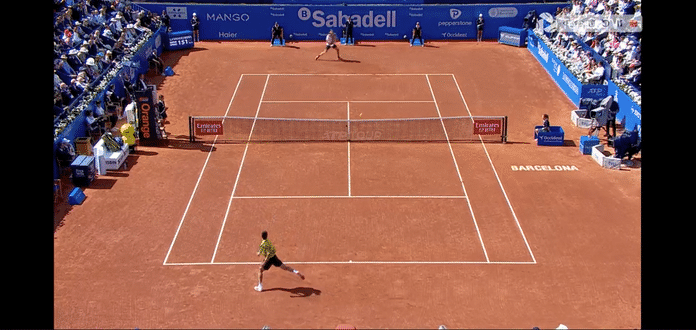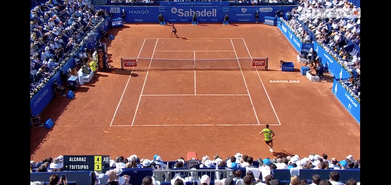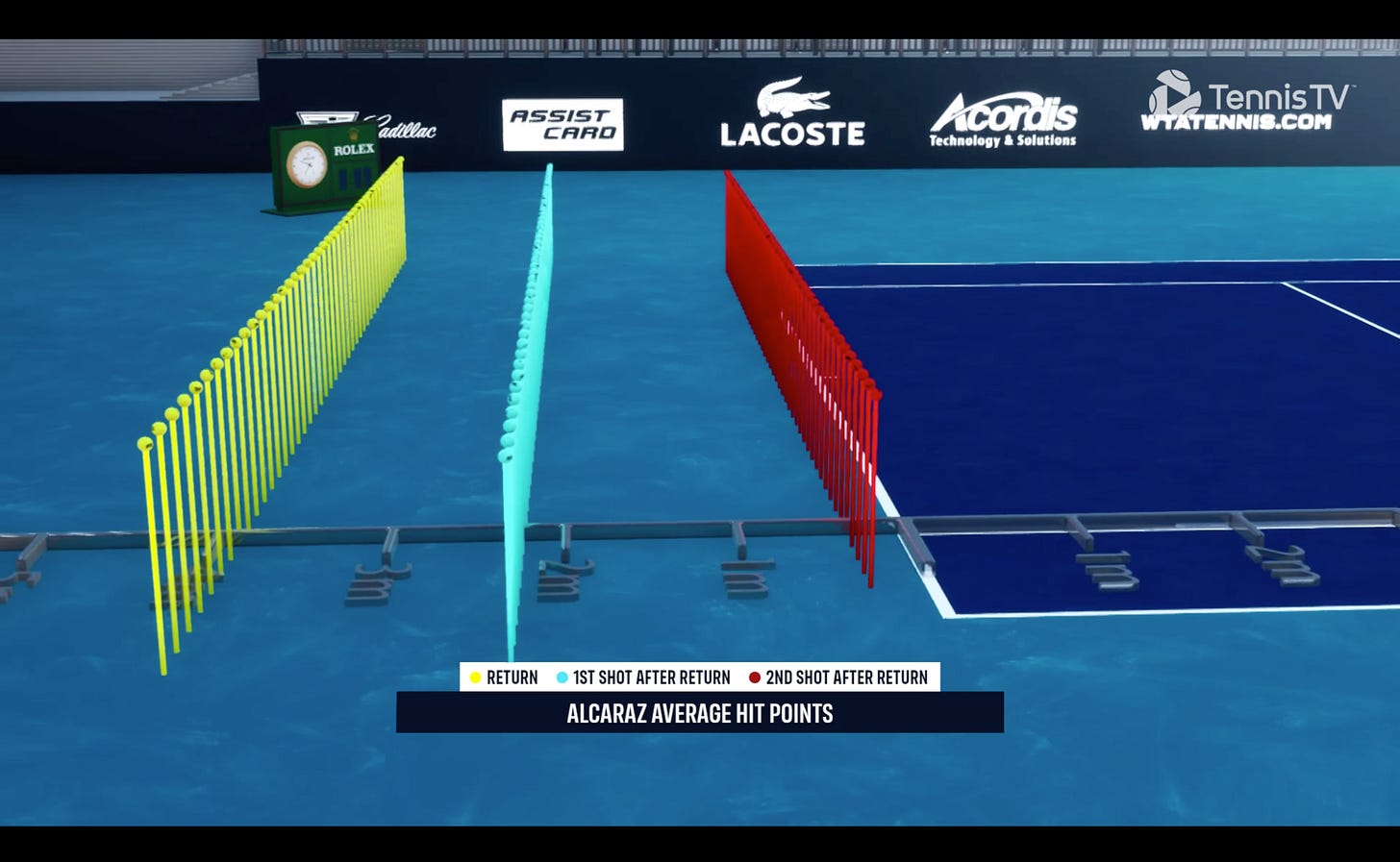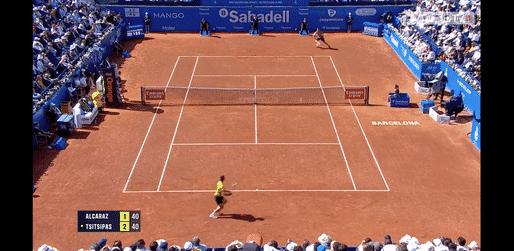Carlos Alcaraz defeated Stefanos Tsitsipas 6/3 6/4 in the final of the Barcelona ATP 500 on Sunday. Since returning from injury and missing this year’s Australian Open Alcaraz has gone 23-2, making the final in four out of five events he entered. He now leads Tsitsipas 4-0 in their H2H.
An excerpt from the Alcaraz/Tsitsipas match analysis from Miami 2022 quoting Alcaraz in his post-match interview:
"I knew that Stefanos is a player who always is looking for his forehand," Alcaraz said, describing his game plan. "I tried to hit two or three backhands cross-court and then switch to down the line, to his running forehand. It was a key. I think he [Tsitsipas] lives in the backhand side all the time, looking for his forehand, as I said. It was pretty important, the backhand down the line."
On the faster hard courts in Miami the backhand-down-the-line was Alcaraz’s preferred mode of attack to get Tsitsipas off his backhand mound, but here on the hot clay of Barcelona, Alcaraz had time to run around and find more forehands. The very first point of the match highlighted why Tsitsipas is always going to struggle against Alcaraz. The young Spaniard tenderized the Greek’s backhand with his high and heavy forehands, before dancing around his backhand and ripping an inside-in forehand winner.

The ad-court kick serve out wide is a stock play for Alcaraz on any surface, it sets up his forehand so well on the next ball. But on clay, and against Tsitsipas, it is bread-and-butter:

It also highlights how simple Alcaraz can keep his tactics when playing Tsitsipas, especially on clay. Whenever Alcaraz needs some breathing room, he can often reset the point in his favor by hitting high and heavy into the Tsitsipas backhand, knowing there is little threat of attack down-the-line with the extra bounce getting the ball high above the Greek’s strike zone. The backhand wing has continually let down Tsitsipas in many big matches (clay or otherwise). The top players expose it nearly every time.1 In that first service game, Alcaraz served all four times to the Tsitsipas backhand, often with heavy kick. This earned him two free points via missed returns. On the other two points, Alcaraz was able to find a forehand after the serve and take control of the point, using 2-1 patterns with his forehand into Tsitsipas’ backhand.

Despite these tactical headwinds, Tsitsipas was the first to draw blood in the third game of the match, breaking Alcaraz off the back of three poor errors from the Spaniard. It also appeared the highest and heaviest Tsitsipas would hit his backhand for the match, and something I think he needs to do more on clay next time they play. However, Alcaraz broke straight back the very next game (perhaps unsurprising, given he had been breaking opponents at a clip just north of 50% for the week. That’s a silly number).
Wormholes, Drop Shots, and North-South Play
The opening point of the third game highlighted a unique attribute of Alcaraz’s game: his “North-South” movement and awareness are unparalleled.2 What does that mean? While much of the game has seen a drastic improvement in the defensive, lateral, aspect of player movement in the last 20 years (there is a great piece by Matt Willis of
that you can read here on this) Alcaraz is the first player I can think of who consistently transitions up the court from brilliant defense to brilliant offense in two balls. To explain: most players hit a defensive shot well (shot 1), then move up the court closer to the baseline, reset themselves, and play the neutral ball (ball 2). Having struck that particularly well, and perhaps seeing their opponent with an open racquet face (hinting at a slice) or out of position, they move forward for the winning blow (ball 3). Alcaraz just completely does away with any notions of “resetting himself”. He wormholes from sliding defensive balls behind the baseline to gliding forecourt volleys in the time it takes his opponent to slash at a defensive ball:Commentator: “How on earth did he get to the net as quickly as he did there? Mind boggling….Where did he come from there?”
Gilles Muller: “The anticipation there is amazing. As soon as he hit that backhand, he was already on the run to the net. Just taking away so much time from Tsitsipas.”
Below here Alcaraz only needs a fraction of a second to recognize Tsitsipas is wrong-footed, and although the ball is close to the Greek, and Alcaraz is several feet behind the baseline, he jets off to the net anyway. It’s great to watch:
It’s a feature of his game that I touched on after his Indian Wells victory over Jannik Sinner:
Below we see the Alcaraz north-south game within a defensive framework:
Around this time last year, I wrote of Alcaraz:
Alcaraz loves to attack, but you can see that he marries that aggressive instinct with a determination to get started in a lot of points by returning from very deep in the court. The below graphic was from the Miami Masters back in March (which Alcaraz won).
And it’s not just Alcaraz’s North-South off-the-ball movement that is phenomenal. His north-south shot selection is too. Once again, the Alcaraz drop shot played a huge role in this match. Yes, he has gifted touch, but what makes Alcaraz’s drop shot special is that it is attached to such a huge and offensive game. It is the Alcaraz power game and aggressive court positioning that undoes opponents on the drop shot; they are often split-stepping from deep positions, or over-committing their movement in anticipation of a well-struck ball taken inside the baseline. In the points below note how often Alcaraz (a) hits the drop shot from well inside the baseline, and (b) plays his drop shots in the opposite direction players are moving:

Below: Alcaraz plays this backhand drop shot left while Tsitsipas is recovering right.
Below: Alcaraz plays the forehand drop shot left where Tsitsipas is split-stepping in anticipation to the right:
Below: Alcaraz plays the forehand drop shot right where Tsitsipas is recovering left:
The other bonus on the Alcaraz forehand drop shot, in particular, is that with his modern upright forehand setup position, it is so well disguised; a minor grip tweak from his semi-western forehand grip is all that is needed before chopping down and deploying the dropper:

Alcaraz would hit 10 forehand drop shot winners and 1 backhand drop shot winner for the match, missing in the net on two other attempts to finish with an 11/13 conversion. Which is ridiculous. That’s almost half a set’s worth of drop-shot points. By comparison, Tsitsipas went 2/5.
The other players just haven’t built up this level of instinctive awareness in their forecourt game (and very few have the offensive power to complement a short game as effectively as Alcaraz does). Tsitsipas has the perfect offensive forehand for a drop shot, he can take it early and hard in both directions, but you can see he hasn’t weaved the drop shot into the fabric of his game since his youth; it’s a work in progress that began recently (probably when everyone saw how well Alcaraz was using it). Note below that Tsitsipas plays it off his backhand wing and in the same direction that Alcaraz is recovering back to the middle. Firstly, Tsitsipas’ backhand just isn’t big enough to warrant Alcaraz positioning himself deep enough behind the baseline to make this a percentage play, second, Tsitsipas is behind the baseline when he attempts this, and third, Tsitsipas hits this down-the-line (left) while Alcaraz is also recovering left. Too easy for Carlitos:
And perhaps Tsitsipas felt the need to tap out of the backhand in the above point because he knows more than anyone the pressure that backhand pattern exerts on his game. There is no escape from Alcaraz. The frustration often boils over in the kind of tank slaps that have appeared in numerous matches against his younger opponent:
Commentator: “The challenge for Tsitsipas, for me, Gilles, is how he defends the backhand corner, because, when they’re is a lot of pressure off that wing we can see that it can breakdown, and of course, he’s looking to get that forehand into play so he’s actually giving a lot of court space up, and it’s making life a little difficult for him.”
Gilles: “And the solution for that is not easy, you have to try to change it up a little bit. He’s trying to use the slice, but you have to be very careful, the slice can not go up too high. It has to stay low, otherwise, Alcaraz has too much time.”
I’ve already mentioned that Alcaraz is far better at attacking with his backhand down-the-line, but the slap in the face for Tsitsipas is that Alcaraz—the younger, double-handed Spaniard—has a far better slice, and his defensive options off that wing are numerous and refined. Here he keeps the slice low and short so that Tsitsipas is forced to approach with a lot of topspin and not much speed on the ball. Alcaraz then lobs Tsitsipas with perfect length:
Although the scoreline finished with just one break in each set separating them, in the words of Gilles Muller, Tsitsipas “didn’t stand a chance at all.” This was an exhibition in tearing apart the game of the world number 5 and one of the best clay courters going around. A demolition job. The other commentator also chimed in with a pretty fair assessment:
“It’s sometimes easy in these situations to dip into a spot of hyperbole, but, it's been so easy on the eye.”
By the official TennisTV stats, Alcaraz put up some pretty special numbers:

By my count using my proposed metrics (that you can read explained here):
A recent summary of Alcaraz is worth mentioning here again after this kind of performance:
“At his best, Alcaraz is already one of the most complete players the game has ever seen. His serve is touching the high 130s, his forehand is one of the best in the game, his backhand is a reliable shield that he can also attack with, and his intangibles—the drop shot, slice, volleys, and court awareness—are the best in the game as a package. Oh and he’s quick as shit. With a great attitude.”
In another piece I noted how Djokovic builds pressure in subtle ways, using depth and line balls rather than outright power or rushing:
Corner defence married with controlled depth and subtle change-of-direction may not make for good highlight reels, but it allows him [Djokovic] to effortlessly tear apart quality top-20 opposition without getting out of mid-gears.
But Alcaraz’s pressure is more akin to Federer's. It’s the relentless attack from every part of the court, and then using every part of the court to expose his opponent. This is the key distinction between Alcaraz and his company (Sinner, Auger-Aliassime, Tsitsipas, Rublev, Fritz, etc.). None can hold a candle to his variation
If there’s a silver lining for Tsitsipas it may be that getting Alcaraz running to his forehand provides him with a small crack that he can look to expose. The problem is, the tool required to open it involves a well-struck backhand down-the-line. That’s going to be hard. Maybe too hard. As Tsitsipas said to Alcaraz in his post-match speech: “Take it easy, Hermano.”
At the beginning of the year I wrote a piece on tradeoffs. An excerpt:
…I still believe the best technique emphasises a reduction in lag/whip/flip on the outside. Djokovic, Nadal, Medvedev, Rune, Alcaraz, and Ruud put themselves in the best position to benefit as they hit technical landmarks across serve, forehand, and backhand that allow them to maintain that high level Robbie Koenig was mentioning (coupled with great movement). Of course, the game is more than just technique—talent, athleticism, mental strength, fitness, strategy, and work ethic are all instrumental—but I do think technique plays an outsized role at the very top of the game where margins are razor thin.
The paragraph also went on to say:
Relying on this thesis of technical simplicity, Holger Rune is my pick of the bunch to push higher in the rankings again this year. He has such simple swing mechanics along with great athleticism, intangibles (drop shots, variation), and determination. It will be interesting to track his progress alongside others in his cohort, such as Alcaraz, Sinner, Auger-Aliassime, and Musetti.
Rune came through a clutch third-set tie-breaker in the final of the Bavarian International to also defend his title this week, and he is my pick to be a true challenger to Alcaraz in the coming years. He has the game, and more importantly, I think he has the belief and desire, to put himself in that company.
The tour lands in Madrid this week for the second clay Masters 1000. I’ll be back near the end of the tournament with some match reviews and thoughts.
Tsitsipas is now 2-13 in events at 500 events or above (1000s, World Tour Finals, and Slams). He is now 0-10 in 500 finals.


















Hugh, thanks again. I enjoy your analysis so much. Reading this one and with the memory of the Tsitsipas vs Musetti semi fresh in mind, I went back to the article you wrote about the Hamburg final last year. The first and most obvious observation is that Alcaraz has raised to yet greater heights since Hamburg. The second though is how different the ad side dynamic is between Tsitsipas and Musetti, and what this means for the opponent, especially in this clay court context. Could I be forgiven for thinking having a strong backhand may be more advantageous than having a super forehand?
Nice content!
Nitpicky, but Alcaraz is 4-0 against Tsitsipas and he’s made 4/5 finals this year due to the Miami semis loss